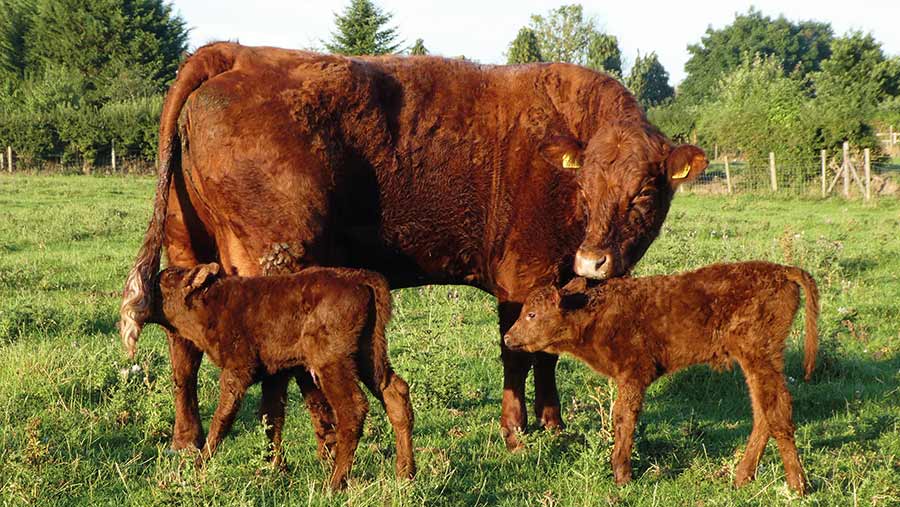5 ways to reduce assisted calvings for improved fertility
 © Terence Pye
© Terence Pye Bad calvings are bad for business, yet too many farmers are still assisting cows at calving. This is something suckler farmer Terence Pye believes must change.
“We know bad calvings are bad for welfare, yet working on reducing assistance at calving doesn’t get talked about much,” he says.
“Plenty of farmers are still pulling plenty of calves. Do they like doing it?”
See also: What is pelvic scoring and how valuable is it for calving?
“Calving is something that should be happening by itself. It is the single biggest thing you can do to improve the financial performance of your suckler herd,” says Mr Pye, who runs a pedigree herd of Salers at Middleton-on-Leven, North Yorkshire.
He says the balance between terminal and maternal traits needs adjusting to make the suckler cow more functional.
Too much focus has been placed on terminal sire traits as breeders and farmers’ desire for shapely suckler cows has been to the detriment of calving ease.
He has reduced assistance rates to just one in 222 cows and two in 52 heifers over the past four years.
Key to this has been pelvic scoring of heifers and selecting sires to give an “appropriate” calf birthweight as well as strategically using the myostatin gene.
Farm vet Gareth Mulligan, from Afon Vets in Neath, also spoke about the importance of reducing bad calvings and carrying out basic breeding checks.
Mr Mulligan says traumatic calvings have knock-on consequences for cow health, subsequent fertility and calf performance.
They can affect the maternal bond, reduce colostrum intake and delay the cow’s return to service.
“As an industry, we must improve the breeding efficiency of our suckler herds because it is nowhere near where it needs to be. It isn’t rocket science; these are basic principles,” he says.
Mr Pye and Mr Mulligan share their action plan for improving fertility within suckler herds.
1. Pelvic-score heifers
You cannot tell by eye if a heifer has a wide enough pelvis for birthing a calf; it must be measured internally.
Do not select the biggest pelvis – this will increase cow size – but do eliminate animals that have a narrow one.
Find a vet experienced at pelvic scoring and do it twice to ensure good accuracy. Ideally, score heifers pre-bulling and aim for 140sq cm at 13 months.
If your heifers have small pelvises, look at the bull you have chosen to breed replacements – make sure he has been measured at 15 months of age and he has reliable predictions for a larger pelvic area.
2. Monitor calf birthweight
For your heifers, use a bull with a low birthweight estimated breeding value (EBV) with a good degree of accuracy (>85%). Weigh the calves afterwards to see if the bull’s prediction was accurate and keep records.
Heifer calves born in Mr Pye’s Rigel herd range from 32-36kg at birth and bulls weigh 36-40kg.
3. Consider the myostatin gene
The myostatin gene controls muscle growth and is beneficial for terminal sires but has disadvantages on maternal traits such as calving ease.
Mr Pye makes sure his cows have no copies of the gene, but bulls have one to two copies.
4. Pregnancy-diagnose cows
Lots of farmers still do not pregnancy-diagnose all their cattle, but this means “passenger” animals are being carried, at a great cost to the business.
British Cattle Movement Service data show only 82% of suckler cows produce a calf every year, with a suckler cow not covering her costs until she produces her third calf.
The earliest females can be scanned is six weeks after the bulls have been taken out.
5. Carry out pre-breeding examinations of bulls and females
Carry out genital examinations of the uterus and ovaries to ensure females are cycling. Non-breeders can then be identified early on.
Heifers should be checked at 13 months at the same time as pelvic scoring. Suckler cows are anoestrus for 50-60 days after calving so they should not be done any earlier than this.
Mr Mulligan stresses pre-breeding bull checks are “fundamental” and should be carried out at least six to eight weeks before breeding to allow enough time for issues to be rectified or an alternative bull sourced.
He says one client spent £5,000 on a bull that had failed to get a single cow in-calf.
“You can spend years getting your calving pattern down and the bull goes wrong and puts you back to square one.”
Terence Pye and Gareth Mulligan were speaking at the British Cattle Breeders Conference on 24 January
